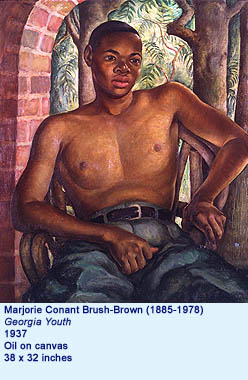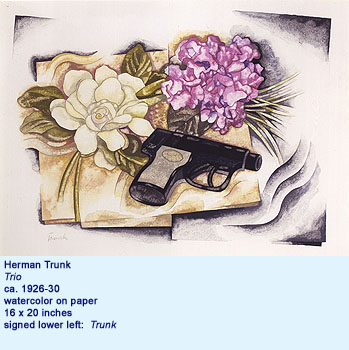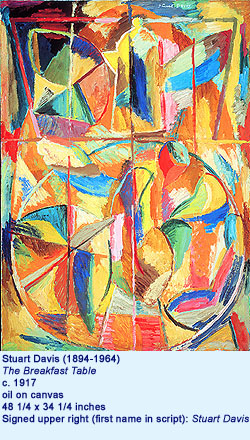

The show will feature 54 works by 46 artists, and is intended to represent a sampling of the stylistic range and diversity of American art over a forty-year period, from 1909 to 1959. Several artists in the show remain dedicated to the tradition of figurative painting, each of whom developed styles that reflect their unique vision of the world: Paul Cadmus, Arthur B. Davies, Jared French, Samuel Halpert, Earl Horter, Walt Kuhn, Jack Levine, Wallace Putnam, Charles Sheeler, Edward Steichen, and George Tooker. Others pursue a more abstract vision: Manierre Dawson, Stuart Davis, Arthur Dove, Katherine S. Dreier, Werner Drewes, Albert Eugene Gallatin, Carl Holty, and Ad Reinhardt. Many artists consciously sought inspiration from various European styles: the single work in this exhibition by Charles Shaw, for example, is unimaginable without the precedence of Dada collage, whereas the magical realism of Aaron Bohrod, Leon Kelly, Man Ray, Kay Sage, and Florine Stettheimer can be traced to sources in European Surrealism.


chair, looks relaxed as he stares directly at the viewer, suggesting, perhaps, that he no longer fears the years of oppression his forefathers were forced to endure. Witold Gordon (1880s-1968) was known for his illustrations, which appeared in magazines like Vanity Fair, Vogue and The New Yorker (for which he executed eight covers, from 1944-48). He was also a well-known mural painter in the 1930s, having decorated several rooms at Radio City Music Hall and the RCA (now GE) Building in Manhattan. The two still lifes included in this exhibition are examples of Gordon’s proficiency as an easel painter, reflecting his ability to simultaneously capture and convey the grandeur inherent in simple artifacts. Finally, Herman Trunk (1894-1963), an artist who was fairly well-known in the 1920s and 30s, fell into almost total obscurity after his death, only to be resuscitated when his work was discovered by the American commercial market in the late 1980s. He is represented in the exhibition by a magnificent watercolor, one that displays a level of technical execution comparable only to the works of Charles Demuth.
![Witold Gordon (1880s-1968) Untitled [feathers and a ball still life]. ca. 1950. oil on canvas board. 19 x 24 inches. Signed lower right: Witold Gordon.](images/Gordon,%20Witold.jpg)